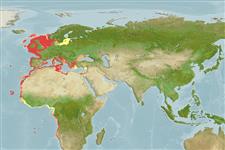>
Eupercaria/misc (Various families in series Eupercaria) >
Sparidae (Porgies)
Etymology: Spondyliosoma: Greek, spondylos = vertebra (1667) + Greek, soma = body (Ref. 45335).
More on author: Linnaeus.
Environment: milieu / climate zone / depth range / distribution range
Écologie
marin benthopélagique; océanodrome (Ref. 51243); profondeur 5 - 300 m (Ref. 3688). Subtropical; 63°N - 20°S, 26°W - 36°E
Eastern Atlantic: Scandinavia to northern Namibia (Ref. 11228), including the Strait of Gibraltar, Mediterranean and the Black Sea, Madeira, Canary Islands, and Cape Verde.
Length at first maturity / Taille / Poids / Âge
Maturity: Lm 19.7 range ? - ? cm
Max length : 60.0 cm SL mâle / non sexé; (Ref. 4781); common length : 30.0 cm SL mâle / non sexé; (Ref. 4781); poids max. publié: 1.2 kg (Ref. 40637)
Épines dorsales (Total): 11; Rayons mous dorsaux (Total): 11-13. Body tall, with weak longitudinal stripes and no dark spots. Snout as long or longer than the eye diameter (Ref. 35388).
Found over seagrass beds and rocky and sandy bottoms to about 300 m (Ref. 3688). Gregarious, sometimes in large schools (Ref. 3688). Omnivorous, feeding on seaweeds and small invertebrates, especially crustaceans (Ref. 3688). Protogynic hermaphrodites (Ref. 4781). An important food fish.
Lays eggs on sandy bottom (Ref. 4781). Sex reversal occurs at approximately 24.3 cm TL in population from Algeria (Ref. 102321). Also Ref. 28504.
Bauchot, M.-L. and J.-C. Hureau, 1990. Sparidae. p. 790-812. In J.C. Quero, J.C. Hureau, C. Karrer, A. Post and L. Saldanha (eds.) Check-list of the fishes of the eastern tropical Atlantic (CLOFETA). JNICT, Lisbon; SEI, Paris; and UNESCO, Paris. Vol. 2. (Ref. 3688)
Statut dans la liste rouge de l'IUCN (Ref. 130435)
Menace pour l'homme
Harmless
Utilisations par l'homme
Pêcheries: commercial; pêche sportive: oui; Aquarium: Aquariums publics
Outils
Articles particuliers
Télécharger en XML
Sources Internet
Estimates based on models
Preferred temperature (Ref.
123201): 7 - 17.2, mean 10.2 °C (based on 645 cells).
Phylogenetic diversity index (Ref.
82804): PD
50 = 0.7500 [Uniqueness, from 0.5 = low to 2.0 = high].
Bayesian length-weight: a=0.01230 (0.01114 - 0.01358), b=3.03 (3.00 - 3.06), in cm total length, based on LWR estimates for this species (Ref.
93245).
Niveau trophique (Ref.
69278): 3.3 ±0.2 se; based on diet studies.
Résilience (Ref.
120179): Milieu, temps minimum de doublement de population : 1,4 à 4,4 années (K=0.3; Fec=36,000; tm=4).
Prior r = 0.47, 95% CL = 0.31 - 0.71, Based on 3 stock assessments.
Fishing Vulnerability (Ref.
59153): Moderate vulnerability (37 of 100).
Climate Vulnerability (Ref.
125649): Moderate vulnerability (41 of 100).
Nutrients (Ref.
124155): Calcium = 51.6 [28.4, 94.8] mg/100g; Iron = 0.873 [0.494, 1.476] mg/100g; Protein = 19 [17, 21] %; Omega3 = 0.394 [0.268, 0.583] g/100g; Selenium = 39.4 [20.0, 72.3] μg/100g; VitaminA = 12.9 [3.9, 37.7] μg/100g; Zinc = 0.742 [0.530, 1.043] mg/100g (wet weight); based on
nutrient studies.
